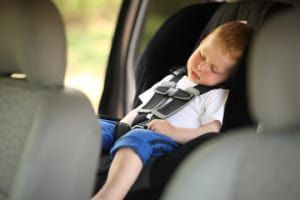 Remembering not to leave your children unattended in a vehicle might seem like a no-brainer, but you’d be surprised how many children are left in a car during a “quick” errand or how easy it is to forget an infant in the backseat. In fact, Safe Kids reports that half of vehicle-related heatstroke deaths among children occur when a distracted caregiver forgot that a quiet child was in the car.
Remembering not to leave your children unattended in a vehicle might seem like a no-brainer, but you’d be surprised how many children are left in a car during a “quick” errand or how easy it is to forget an infant in the backseat. In fact, Safe Kids reports that half of vehicle-related heatstroke deaths among children occur when a distracted caregiver forgot that a quiet child was in the car.
According to Safe Kids, heatstroke is the leading cause of non-crash, vehicle-related deaths for children under the age of 14. San Francisco State University’s (SFSU) Department of Geosciences reports that from 1998 to 2013, 576 children have died from heatstroke after being left in a hot vehicle.
While leaving a child unattended in a vehicle is only illegal in 20 states, Safe Kids and the General Motors Foundation teamed up to create the Never Leave Your Child Alone in a Car campaign to prevent heatstroke-related injuries and deaths among children. The campaign raises awareness of heatstroke among children and educates parents and caregivers on the dangers of hot vehicles.
According to the National Highway Traffic Safety Administration (NHTSA), the temperature within a vehicle can rise above 110 degrees even on a 60-degree day while a SFSU study revealed that the temperature in a closed vehicle can rise about 19 degrees in only 10 minutes. In a similar study, the Animal Protection Institute found that on an 82-degree morning, the temperature inside a vehicle was 109 degrees. By the afternoon, the temperature inside the vehicle rose to 124 degrees. The study also found that even with four windows cracked, temperatures within the car were well over 100 degrees any time of day.
While adults might be able to handle this extreme heat, children’s bodies heat up three to five times faster than an adult bodies, making them more susceptible to heatstroke, according to NHTSA. However, you can help save your children, or even someone else’s children, from heatstroke and other heat-related illnesses by following these tips from Safe Kids and NHTSA :
- Never leave a child alone in a vehicle, not even for a minute
- Lock your car doors and trunks, even in your driveway, and keep all car keys out of reach of children to prevent them from entering your vehicle without your knowledge
- Create reminders to help you remember a quiet infant, such as placing a note where you’ll see it when getting out of the car or simply leaving your cell phone or something else you’ll need for the day next to your child’s safety seat
- Create a habit of looking in the front and back of the vehicle before you get out
- Call 911 if you see a child alone in a car or, if the child is clearly in distress from heat, get him or her out as quickly as possible and cool the child rapidly
- Be aware of heatstroke symptoms, including red, hot, and moist or dry skin; no sweating; strong, rapid pulse or slow, weak pulse; throbbing headache; dizziness; nausea; confusion; being grouchy; or acting strangely
